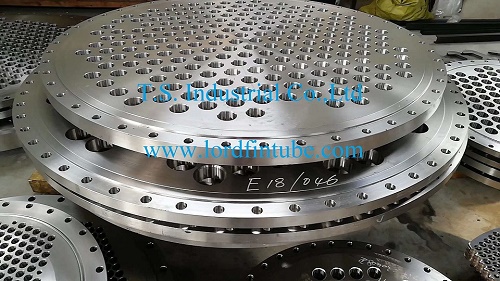Lord Fin Tube-What is 316L stainless tube sheet?
ASTM A182 F316L stainless steel tube sheets are premium-grade components engineered for extreme service conditions in critical industrial applications. With superior corrosion resistance, exceptional mechanical properties, and compliance with international standards, these tube sheets provide reliable performance in demanding environments including chemical processing, marine engineering, and power generation systems.
ASTM A182 F316L Tube Sheet Material Composition & Properties
Chemical Composition
Carbon (C): ≤0.03%
Chromium (Cr): 16.0-18.0%
Nickel (Ni): 10.0-14.0%
Molybdenum (Mo): 2.0-3.0%
Manganese (Mn): ≤2.0%
Silicon (Si): ≤0.75%
Phosphorus (P): ≤0.045%
Sulfur (S): ≤0.03%
Mechanical Properties
Tensile Strength: ≥485 MPa
Yield Strength: ≥170 MPa
Elongation: ≥40%
Hardness (Brinell): ≤217 HB
Density: 8.0 g/cm³
Melting Point: 1375-1400°C
Advantage: Low Carbon Content
The maximum 0.03% carbon content in ASTM A182 F316L prevents carbide precipitation during welding and high-temperature service, eliminating sensitization issues that can lead to intergranular corrosion. This makes F316L particularly suitable for welded construction and high-temperature applications where standard 316 stainless steel would be susceptible to corrosion.
| Property | ASTM A182 F316L Value | Performance Advantage |
|---|---|---|
| Pitting Resistance | PREN: 24-26 | Superior resistance in chloride environments compared to 304/304L (PREN: 19) |
| Stress Corrosion Cracking | Excellent up to 60°C in chloride solutions | Outperforms carbon steel and standard stainless grades in aggressive environments |
| High Temperature Performance | Continuous: 870°C, Intermittent: 925°C | Maintains structural integrity in heat exchangers and boilers |
| Cryogenic Toughness | Excellent down to -196°C | Suitable for LNG and cryogenic applications |
Manufacturing Process & Quality Control
Material Certification & Traceability
All ASTM A182 F316L tube sheets undergo rigorous material certification processes:
Material Testing
• Chemical analysis by optical emission spectrometry
• Mechanical property verification
• Microstructure examination
• Hardness testing at multiple locations
Quality Documentation
• Mill Test Certificates (MTC) per EN 10204 3.1/3.2
• Material traceability with heat numbers
• Compliance certificates for ASTM A182, ASME SA182
Precision Machining Standards
| Machining Parameter | Standard Tolerance | Precision Grade |
|---|---|---|
| Hole Diameter | ±0.05 mm to ±0.1 mm | IT7-IT8 |
| Hole Pattern Layout | ±0.1 mm over full pattern | Laser marked and verified |
| Surface Flatness | 0.1 mm per 300 mm | Machined both sides |
| Surface Finish | Ra ≤ 1.6 μm (63 μin) | Ground or machined |
ASTM A182 F316L Tube Sheet Industry Applications
Chemical Processing
Resists sulfuric acid, phosphoric acid, and chloride solutions at elevated temperatures
Marine & Offshore
Excellent resistance to seawater, marine atmospheres, and biofouling
Power Generation
Withstands high-pressure steam, condensate, and cooling water systems
Pharmaceutical
Sanitary applications with electropolished surfaces (Ra ≤ 0.8 μm)
Performance Comparison in Aggressive Environments
| Environment | ASTM A182 F316L | 304/L Stainless | Carbon Steel |
|---|---|---|---|
| Seawater (25°C) | Excellent | Poor-Fair | Very Poor |
| Dilute Sulfuric Acid | Good-Excellent | Fair | Very Poor |
| Chloride Pitting | Excellent | Poor | N/A |
| High Temp Oxidation | Excellent | Good | Poor |
| Cost-Performance Ratio | Optimal | Good | Poor |
ASTM A182 F316L Tube Sheet Technical Specifications & Standards
International Standards
American Standards
• ASTM A182/A182M - Standard for forged or rolled alloy and stainless steel pipe flanges, forged fittings, and valves and parts for high-temperature service
• ASME SA182 - ASME boiler and pressure vessel code specification
• ASTM A240 - Chromium and chromium-nickel stainless steel plate, sheet, and strip for pressure vessels
European & International
• EN 10088-1 - Stainless steels - List of stainless steels
• EN 1.4404 - Chemical composition and mechanical properties
• UNS S31603 - Unified numbering system designation
Non-Destructive Testing Requirements
| Test Method | Standard | Application Criteria |
|---|---|---|
| Dye Penetrant Testing | ASTM E165 | All accessible surfaces |
| Ultrasonic Testing | ASTM A388 | Forging quality verification |
| Radiographic Testing | ASTM E94 | Critical applications only |
| Hardness Testing | ASTM E10/E18 | Multiple locations |
ASTM A182 F316L Tube SheetFrequently Asked Questions
A: The key difference is carbon content. F316L has a maximum carbon content of 0.03%, while F316 can have up to 0.08%. The lower carbon content in F316L prevents carbide precipitation during welding, making it superior for welded applications and high-temperature service where intergranular corrosion could be a concern.
A: While duplex stainless steels (like 2205) offer higher strength and better chloride stress corrosion cracking resistance, F316L provides better overall corrosion resistance in a wider range of chemical environments, superior weldability, and proven performance across diverse applications. The choice depends on specific service conditions and cost considerations.
A: Recommended welding processes include GTAW (TIG) and SMAW (stick) using matching filler metals (ER316L or E316L-16). Preheating is generally not required, and interpass temperature should be maintained below 150°C. Post-weld heat treatment is typically not necessary for F316L due to its low carbon content.
A: F316L has limited resistance to sulfide stress cracking in sour environments. For applications involving H₂S, special precautions and additional testing are required. Alternative materials like duplex stainless steels or nickel alloys may be more suitable for severe sour service conditions.

ASTM A182 F316L Stainless Steel Tube Sheet - Precision machined for heat exchanger applications

